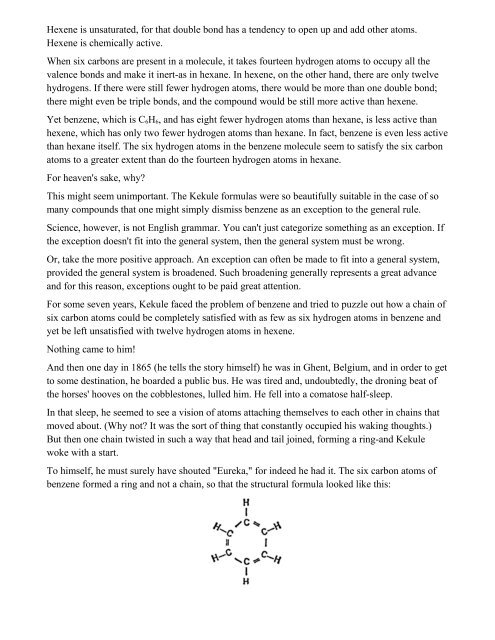The-Eureka-Phenomenon-by-Isaac-Asimov
The-Eureka-Phenomenon-by-Isaac-Asimov
The-Eureka-Phenomenon-by-Isaac-Asimov
You also want an ePaper? Increase the reach of your titles
YUMPU automatically turns print PDFs into web optimized ePapers that Google loves.
Hexene is unsaturated, for that double bond has a tendency to open up and add other atoms.<br />
Hexene is chemically active.<br />
When six carbons are present in a molecule, it takes fourteen hydrogen atoms to occupy all the<br />
valence bonds and make it inert-as in hexane. In hexene, on the other hand, there are only twelve<br />
hydrogens. If there were still fewer hydrogen atoms, there would be more than one double bond;<br />
there might even be triple bonds, and the compound would be still more active than hexene.<br />
Yet benzene, which is C6H6, and has eight fewer hydrogen atoms than hexane, is less active than<br />
hexene, which has only two fewer hydrogen atoms than hexane. In fact, benzene is even less active<br />
than hexane itself. <strong>The</strong> six hydrogen atoms in the benzene molecule seem to satisfy the six carbon<br />
atoms to a greater extent than do the fourteen hydrogen atoms in hexane.<br />
For heaven's sake, why?<br />
This might seem unimportant. <strong>The</strong> Kekule formulas were so beautifully suitable in the case of so<br />
many compounds that one might simply dismiss benzene as an exception to the general rule.<br />
Science, however, is not English grammar. You can't just categorize something as an exception. If<br />
the exception doesn't fit into the general system, then the general system must be wrong.<br />
Or, take the more positive approach. An exception can often be made to fit into a general system,<br />
provided the general system is broadened. Such broadening generally represents a great advance<br />
and for this reason, exceptions ought to be paid great attention.<br />
For some seven years, Kekule faced the problem of benzene and tried to puzzle out how a chain of<br />
six carbon atoms could be completely satisfied with as few as six hydrogen atoms in benzene and<br />
yet be left unsatisfied with twelve hydrogen atoms in hexene.<br />
Nothing came to him!<br />
And then one day in 1865 (he tells the story himself) he was in Ghent, Belgium, and in order to get<br />
to some destination, he boarded a public bus. He was tired and, undoubtedly, the droning beat of<br />
the horses' hooves on the cobblestones, lulled him. He fell into a comatose half-sleep.<br />
In that sleep, he seemed to see a vision of atoms attaching themselves to each other in chains that<br />
moved about. (Why not? It was the sort of thing that constantly occupied his waking thoughts.)<br />
But then one chain twisted in such a way that head and tail joined, forming a ring-and Kekule<br />
woke with a start.<br />
To himself, he must surely have shouted "<strong>Eureka</strong>," for indeed he had it. <strong>The</strong> six carbon atoms of<br />
benzene formed a ring and not a chain, so that the structural formula looked like this:


